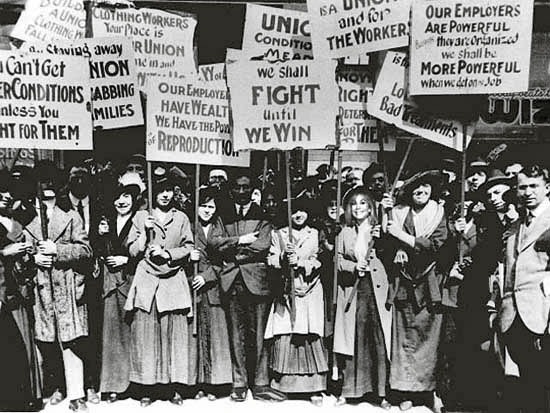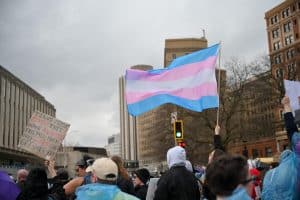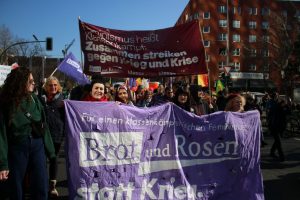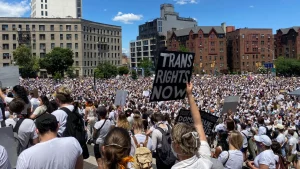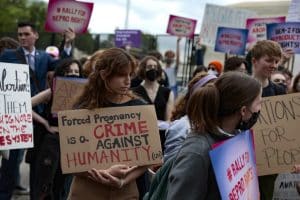The Bread and Roses strike of 1912 is one of the most powerful examples of women workers overcoming national boundaries and language barriers in order to successfully confront bosses and police. It is an example of young women who, far from the stereotype of fragile femininity, fought and won. It is an example of labor organizing across gender, ethnic and language boundaries– usually boundaries that divide the working class.
The 1912 Bread and Roses strike occured in the context of a wave of labor mobilizations and strikes, particularly in the textile industry. In 1908, women workers in Chicago organized for a shorter work day and better work conditions. In 1909, Clara Lemlich helped organize the uprising of 20,000 in New York City, a massive strike of New York’s primarily women and immigrant textile industry.
In this context of labor struggle, on January 11, 1912, predominantly women textile workers in Lawrence, Massachusetts went on a strike that lasted nine weeks. At its peak, 30,000 people were on strike. After Massachusetts passed a law that reduced the work week for women and children to 54 hours as opposed to 56, workers received a proportional pay cut, which they refused to accept. The mill workers wages were so meager that this pay cut meant workers’ children would go hungry and they would be unable to afford basic necessities.
Although the strike began with the Polish workers of Everett Mill, the news spread, and by the next morning thousands of women had joined the strike. Prior socialist organizing and militant actions had helped create the conditions for the workers’ action. For example, in the prior year 87 women had organized a work stoppage for a pay increase, learning lessons they subsequently drew on for the Bread and Roses strike. After the smaller 1911 strike, IWW turned their attention to Lawrence, helping to build relationships and organize meetings with workers. There were 20 different Industrial Workers of the World chapters in the city prior to the strike. The AFL was nowhere to be seen, as at the time, it only organized skilled workers– exclusively white men. Once the strike broke out, the AFL actually opposed it. In fact, some of the IWW’s most important organizers were sent to Lawrence, including J.P. Thompson and Elizabeth Gurley Flynn.
Lawrence was known as “Immigrant City,” as people from 51 different countries occupied 7 square miles, working daily in the local textile mills. 65% of the town’s population had been in the U.S. for less than ten years. The conditions in the mills were horrendous: life expectancy was less than 40 years for mill workers, and one-third died within a decade of starting their jobs. They often died of respiratory infections such as pneumonia due to the dust and lint in the mills. Over half of the children in Lawrence worked in mills, desperate to help their families make a living.
.
A strike commitee representing the language groups of strikers was elected; four representatives of each ethnic group, along with alternates were elected in case the original representatives were imprisoned. Joseph Ettor of the IWW, as well as Arturo Giovannitti of the Italian Socialist Federation of the Socialist Party helped translate meetings into 30 different languages. The Outlook, a local newspaper, said, “There are almost as many nationalities here in Lawrence as there are in your Babel of New York. The workers are American, English, Scotch, Irish, German, French, Flemish, French-Canadian, Polish, Italian, Syrian, Russian, Armenian…. You might not suspect that a common sentiment could animate these diverse groups and weld them into a fighting unit. Nevertheless they have struck—struck as a single homogenous body.”
At the end of each week, there were massive assemblies where the workers decided on the next steps for the strike. The strike committee represented workers from the diverse nationalities involved in the strike. After each meeting, the workers sang “The Internationale.”. Some of the first measures voted by the assemblies were the creation of a strike fund, as well as a massive picket of the factories, resulting in confrontations and police violence against the strikers.
At pickets and parades, strikers carried banners that demanded “Bread and Roses.” The expression came from a poem written in 1911, which reads in part,
Our lives shall not be sweated from birth until life closes;
Hearts starve as well as bodies; give us bread, but give us roses.
As we go marching, marching, unnumbered women dead
Go crying through our singing their ancient call for bread.
Small art and love and beauty their drudging spirits knew.
Yes, it is bread we fight for, but we fight for roses too.
As most of the participants in the strike were women, the strike committee took up several measures to help women fully participate in the strike. These include community cafeterias and childcare. The IWW also formed children’s union meetings and activities for kids to discuss the reasons for the strike as a response to schools who called the strike “un-American”. Flynn wrote, “The IWW has been accused of putting the women in the front. The truth is, the IWW does not keep them in the back, and they go to the front.”
Early in the strike, police shot and killed Anna LoPizzo. IWW leaders were blamed and imprisoned. The governor called in the militia and clamped down on meetings and parades. The militia then killed 18-year-old John Ramey. As a result of this police violence, women sent their children to other cities to live with friends and relatives during the strike. In Manhattan, 5,000 people greeted the arriving children, cheering and providing positive reinforcement for the strike.
When women in Lawrence continued to take their children to the train station , the police beat and arrested them in front of their children. This created a huge media scandal and strengthened public approval for the strike. Around the country, people sent money and letters of support. Even at Harvard, students went to Lawrence to show solidarity with the strike. Despite the outpouring of public support, the AFL continued to oppose it, calling the organizers anarchists.
As a result of the bad press after the children’s exodus, the government was forced to act. Congress began a hearing on the strike on March 2, and the horrible conditions in the mills became public. On March 14, the mill owners agreed to a 15% pay increase for workers, plus higher overtime pay, and promised not to retaliate against the strikers.
As a result of the Bread and Roses strike, 275,000 New England textile workers also received similar wages, as employers feared that the workers would follow suit and engage in similar strikes.
The Bread and Roses strike served as inspiration for among one of the largest socialist women’s organization in Latin America: Pan y Rosas. This organization exists in Chile, Bolivia, Venezuela, Brazil, Costa Rica, Perú, México, Argentina, Germany and Spain. In Argentina alone, they number over 5 thousand women. Read the Bread and Roses manifesto here and about the organizing that Pan y Rosas Argentina has worked on including work stoppages against femicides, as well as against sexual harassment in the workplace.
The rank and file women who dared to face off against police, risk their jobs and their lives in the strike are not merely a beautiful historical example. These women and men who organized across gender, ethnicity and language are an inspiration for working class people around the world who also dare to demand the right to bread, as well as roses.
Citations:
Forrant, Robert. The Real Bread and Roses Strike Story Missing from Textbooks, 2013.
Klein, Christopher. The Strike That Shook America, 2012.
Lawrence History Center, Bread and Roses Strike of 1912: Two Months in Lawrence, Massachusetts, that Changed Labor History, 2013.


